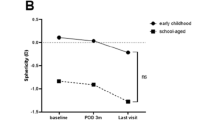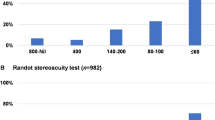Abstract
Objective
To investigate the difference in the rate of myopia progression between the dominant and non-dominant eye in patients with intermittent exotropia (IXT).
Methods
We retrospectively reviewed the medical records of 33 patients who underwent surgery and later reoperation for IXT. We included only patients whose spherical equivalent refractive errors (SER) were ≤ − 0.50 diopter (D) in at least one eye at the time of reoperation. The main outcome measurement was the rate of myopia progression, which was defined as the mean annual change in SER between the first and second surgery. We classified patients into two groups: group A, which comprised 25 patients whose non-dominant eyes showed a faster myopia progression than their dominant eyes, and group B, which comprised the remaining 8 patients showing the opposite.
Results
Mean age of the patients at the time of the initial surgery was 5.64 years. Mean interval between the initial and second surgery was 4.45 years. Mean rate of myopia progression over the interval was − 0.37 D/year in the dominant eyes and − 0.50 D/year in the non-dominant eyes (P < 0.001). Group A had a significantly greater amount of distance deviation (31.0 vs. 25.6 PD, P = 0.020) and near deviation (30.8 vs 26.0 PD, P = 0.039) before the initial surgery and a significantly worse score of distance control (3.05 vs. 2.00, P = 0.023) before the second surgery than group B.
Conclusions
The non-dominant eyes experienced a faster myopia progression than the dominant eyes in patients with IXT. This faster myopia progression demonstrated in the non-dominant eyes was associated with clinically severe exotropia in terms of the amount of deviation and the degree of control.

Similar content being viewed by others
References
Ingram RM, Gill LE, Lambert TW (2003) Emmetropization in normal and strabismic children and the associated changes of ansiometropia. Strabismus. 11:71–84
Walsh LA, Laroche GR, Tremblay F (2000) The use of binocular visual acuity in the assessment of intermittent exotropia. J AAPOS 4:154–157
Ahn SJ, Yang HK, Hwang JM (2012) Binocular visual acuity in intermittent exotropia: role of accommodative convergence. Am J Ophthalmol 154(6):981–986
Ha SG, Jang SM, Cho YA, Kim SH, Song JS, Suh YW (2016) Clinical exhibition of increased accommodative loads for binocular fusion in patients with basic intermittent exotropia. BMC Ophthalmol 16(7):77
Ekdawi NS, Nusz KJ, Diehl NN, Mohney BG (2010) The development of myopia among children with intermittent exotropia. Am J Ophthalmol 149:503–507
Shin KH, Hyun SH, Kim IN, Paik HJ (2014) The impact of intermittent exotropia and surgery for intermittent exotropia on myopic progression among early school-aged children with myopia. Br J Ophthalmol 98:1250–1254
Pan CW, Ramamurthy D, Saw SM (2012) Worldwide prevalence and risk factors for myopia. Ophthalmic Physiol Opt 32(1):3–16
Morgan IG, Ohno-Matsui K, Saw SM (2012) Myopia. Lancet 379:1739–1748
Mapp AP, Ono H, Barbeito R (2003) What does the dominant eye dominate? A brief and somewhat contentious review. Percept Psychophys 65(2):310–317
Cheng CY, Yen MY, Lin HY, Hsia WW, Hsu WM (2004) Association of ocular dominance and anisometropic myopia. Invest Ophthalmol Vis Sci 45:2856–2860
Linke SJ, Baviera J, Munzer G, Steinberg J, Richard G, Katz T (2011) Association between ocular dominance and spherical/astigmatic anisometropia, age, and sex: analysis of 10,264 myopic individuals. Invest Ophthalmol Vis Sci 52:9166–9173
Chia A, Jaurigue A, Gazzard G, Wang Y, Tan D, Stone RA, Saw SM (2007) Ocular dominance, laterality, and refraction in Singaporean children. Invest Ophthalmol Vis Sci 48:3533–3536
Quah BL, Lu Y, Smith D (2001) The association of ocular dominance and the preferred eye for fixation in intermittent exotropia: a guide to choosing the eye for unilateral surgery. Am Orthopt J 51:111–115
Kim H, Kim DH, Ahn H, Lim HT (2017) Proposing a new scoring system in intermittent exotropia: towards a better assessment of control. Can J Ophthalmol 52:235–239
Whitman MC, MacNeill K, Hunter DG (2016) Bifocals fail to improve stereopsis outcomes in high AC/A accommodative esotropia. Ophthalmology 123:690–696
Yang HK, Hwang JM (2011) Decreased accommodative response in the nondominant eye of patients with intermittent exotropia. Am J Ophthalmol 151:71–76
Zhao J, Mao J, Luo R, Li F, Munoz SR, Ellwein LB (2002) The progression of refractive error in school-age children: Shunyi district, China. Am J Ophthalmol 134(5):735–743
Hyman L, Gwiazda J, Hussein M, Norton TT, Wang Y, Marsh-Tootle W, Everett D (2005) Relationship of age, sex, and ethnicity with myopia progression and axial elongation in the correction of myopia evaluation trial. Arch Ophthalmol 123(7):977–987
Author information
Authors and Affiliations
Corresponding author
Ethics declarations
Conflict of interest
The authors declare that they have no conflict of interest.
Ethical approval
All procedures performed in studies involving human participants were in accordance with the ethical standards of the institutional review board of the Asan Medical Center and with the 1964 Helsinki declaration and its later amendments or comparable ethical standards.
Informed consent
The requirement for obtaining informed consent was waived due to the retrospective nature of this study by the institutional review board of the Asan Medical Center.
Additional information
Publisher’s note
Springer Nature remains neutral with regard to jurisdictional claims in published maps and institutional affiliations.
Rights and permissions
About this article
Cite this article
Moon, Y., Kim, J.H. & Lim, H.T. Difference in myopia progression between dominant and non-dominant eye in patients with intermittent exotropia. Graefes Arch Clin Exp Ophthalmol 258, 1327–1333 (2020). https://doi.org/10.1007/s00417-020-04700-0
Received:
Revised:
Accepted:
Published:
Issue Date:
DOI: https://doi.org/10.1007/s00417-020-04700-0




